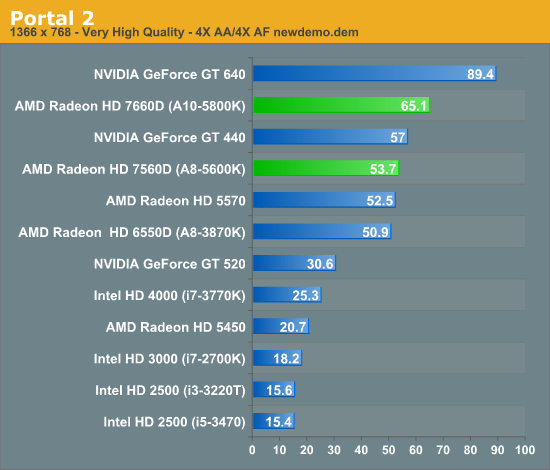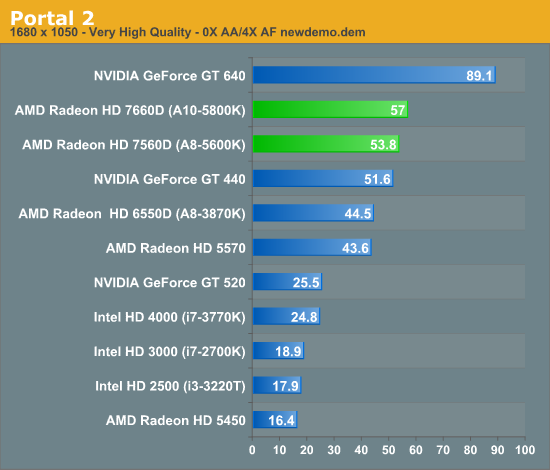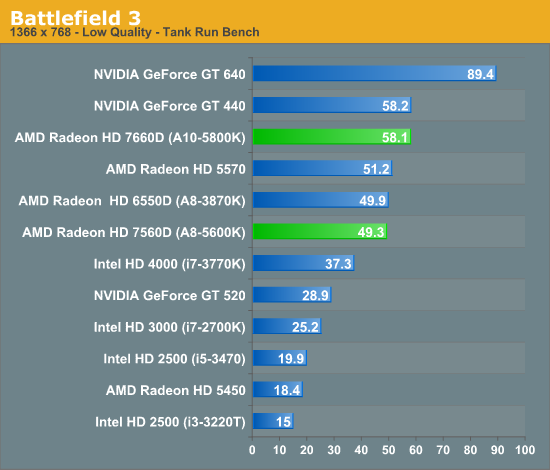AMD A10-5800K & A8-5600K Review: Trinity on the Desktop, Part 1
by Anand Lal Shimpi on September 27, 2012 12:00 AM ESTPortal 2
Portal 2 continues to be the latest and greatest Source engine game to come out of Valve's offices. While Source continues to be a DX9 engine, and hence is designed to allow games to be playable on a wide range of hardware, Valve has continued to upgrade it over the years to improve its quality, and combined with their choice of style you'd have a hard time telling it's over 7 years old at this point. From a rendering standpoint Portal 2 isn't particularly geometry heavy, but it does make plenty of use of shaders.


Portal 2 performance is one of the stronger showings for Trinity. In both of these tests we're seeing aorund a 28% increase in performance compared to the A8-3870K. Ivy Bridge doesn't stand a chance as the A10-5800K is more than twice as fast as Intel's HD 4000.
Battlefield 3
Its popularity aside, Battlefield 3 may be the most interesting game in our benchmark suite for a single reason: it was the first AAA DX10+ game. Consequently it makes no attempt to shy away from pushing the graphics envelope, and pushing GPUs to their limits at the same time. Even at low settings Battlefield 3 is a handful, and to be able to run it on an iGPU would no doubt make quite a few traveling gamers happy.

We're back down to more modest gains in our Battlefield 3 test: Trinity shows a 15% increase in performance compared to Llano at the high end. The advantage compared to Intel remains healthy at over 50%.










139 Comments
View All Comments
OCedHrt - Thursday, September 27, 2012 - link
The Adobe suite is quite well GPU accelerated now. I'll admit Intel still wins on video encoding by far though. And we just saw how Trinity won at gaming, what are you saying?StevoLincolnite - Thursday, September 27, 2012 - link
Actually... The higher the resolution the smaller the increase in performance a processor provides as you quickly become GPU limited.I game at 5760x1080 and I noticed zero, I mean zero difference in games between a Phenom 2 x6 1090T and my current Core i7 3930K.
Granted I use that CPU grunt for other things, but in gaming and at super high resolutions, the difference is absolutely negligible.
I would have been better off using the $800 that I spent upgrading for another 2 graphics cards for Quad-Crossfire if the sole purpose was gaming.
CeriseCogburn - Thursday, October 11, 2012 - link
Don't you love it how with the amd HD7970 etc all their videocards, all we heard about was future proofing and having 2G+ 3G+ ram on board so that WHEN the time came and games were released the dear fanboy amd card could finally show it's unlocjked potential and futureproofiness !LMAO - now a crap trinity slug is all anyone will ever need.
It's amazing what size brain farts the amd fanboy mind can flatulate.
daos - Thursday, September 27, 2012 - link
Not trying to knock AMD at all here either. I want to make that clear. I am simply saying that Intel is the performance king. Once can argue that power consumption is not a concern but performance is.tecknurd - Thursday, September 27, 2012 - link
What blackmagnum means is back in the old days AMD suit the best price vs performance ratio.. These days AMD is not doing this. It nice to get a processor that is as powerful or fast as Intel high-end processor which is i7 for the price of an i5 or even an i3. This provides a good selling point. If user went with a lower end AMD processor, people will be paying less than a Pentium, but get the same performance as an i5 or an i3. It was like this in the past, but again it is not now. AMD's processors have a poor price to performance ratio that is making them more expensive than Intel's processors. Intel has the best price to performance ratio.If you do not believe me, an AMD K7 processor compared well against Intel Xeon processor. Also an AMD K8 processor compared well against Intel Xeon processor. The AMD K10 processor and now compared well against Intel low-end processors like the Pentium, but at a rip off price that is a few times more.
It is already given that an SSD increases performance of a computer because the latency is less than a millisecond and throughput is more than 100 megabytes per second. A HDD latency is about 10 millisecond and throughput is average around 40 to 60 megabytes per second.
vgray35@hotmail.com - Thursday, September 27, 2012 - link
The bottom line here is graphics fusion onto the CPU chip is moving extremely slowly. AMD is now as slow or slower than Intel in moving the technology forward. The incremental improvements from one generation to the next are certainly not spectacular. Intel is slow as they traditionally are too conservative and GPU design has never been their forte. Now AMD is slow as big improvements will eat into their graphics cards business.AMD is backing itself into a corner that it may not ever recover from if it does not make big moves soon. My advise - skip 22nm lithography and go straight to 14nm to 18nm with 5 billion transistors, and increase graphics performance by at least 150% to 200%. Bite the bullet and move low to medium end discrete graphics onto the APU as originally promised. Intel will not be able to match this for at least 2 to 3 years (unless they buy NVidia). Forget power consumption beyond 65W.
They do not need to beat Intel in CPU performance, but it is ridiculous to produce a chip with only 1.1 billion transistors that offers both CPU and GPU cores at this late stage of the game. When Intel moves to 14nm the state of AMD's development at that time will determine AMD's fate once and for all. They had better get a clue and skip one lithographic generation.
I have always favored AMD for its agility in the past, but for years I have been sadly watching the death of this company. It's not too late, but 2 years is all they have left to provide a large incremental jump. It's now or never. The next generation on the new FM2 socket is just not going to cut it either, as the next chip should integrate the south bridge, as well as audio to create a true SoC offering.
Can you believe a new platform that does not even offer PCI Express 3.0? Ridiculous really. Forget 3Gbps SATA. Forget USB 2.0 ports. Produce what we have all been waiting for - a SoC for the desktop, which is what fusion was all about in the first place. If it needs a new APU socket then just bite the bullet and introduce another one, and give it some spare pins for future growth.
Time to get serious. before the money runs out.
mikato - Monday, October 1, 2012 - link
Well just wait until some of the bigger name applications out there start using the GPU a bit. Could be interesting. Hopefully it's sooner rather than later. They do have a way to go with sorting out the best ways to do this.jjj - Thursday, September 27, 2012 - link
I had one question about desktop Trininty: how does it do at 1080p? and i guess i'll have to look for an answer elsewhre.It's a desktop part,you just can't not even try testing at 1080p.
Bah!
Mathieu Bourgie - Thursday, September 27, 2012 - link
I'm also disappointing in the lack of testing at 1080p. Many folks, myself included, are considering Trinity for a HTPC solution and needless to say, the vast majority of hooked to HDTVs, most of them being 1080p. Not to mention that 1080p screens for desktop PCs are quite inexpensive and pretty common nowadays.Also, shame on AMD for those shady marketing tactics. To me, it sounds like CPU performance and overclocking are poor and pricing will most likely depend on reaction to
Mathieu Bourgie - Thursday, September 27, 2012 - link
Sorry about that, I meant to say in my last sentence:"To me, this marketing strategy from AMD is telling me that CPU performance and overclocking potential are most likely poor and that pricing will most likely depend on the reaction of the public and the PC industry after reading these so called "reviews"."